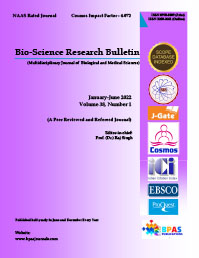Exploring the Potentials of Some Pre-Treatments on Seed Germination of Monodora myrstica
DOI:
https://doi.org/10.48165/Keywords:
Coefficient of velocity, Germination percentage, Monodora myrstica, Pre-treatmentAbstract
Investigation on seed dormancy and germination of Monodora myrstica was carried out. Five pre-treatment methods which included the use of chemical, mechanical scarification, vernalization, wet heat and coconut water were examined. The treated and untreated seeds were sown in Petri-dishes and were moistened with distil water. The untreated seeds served as the control. The percentage seed germination (GP) and coefficient of velocity (CoV) of the germinating seedlings from the treated seeds were compared to those of the control. All the pre-treatments used in this study resulted in better GP and CoV. This tends to suggest that M. myristica exhibits seed dormancy that the treatments must have broken. Germinations in seeds pre-treated with sulphuric acid were directly proportional to the concentrations of the acid. In the mechanical scarified seeds, treatment with sandpaper had the highest germination. The vernalization pre-treatments revealed that the longer the duration of treatment of the seeds the better their germination. Also in the wet heat pre-treatments, seeds immersed for longer time resulted in better germination. Similarly, germinations in the coconut water pre-treated seeds were directly proportional to the duration of treatments. In all the pre-treatments used in this study, seeds treated with 80% concentration of H2SO4 had the highest GP and CoV values. In conclusion, pre-treatment of seeds of M. myristica will be advantageous in the efforts to domesticate the species. The use of wet heat method provides a promising method of pre-treating the seeds of this species in the study area.
References
Aghilian, S., Khajeh-Hosseini, M and Anvarkhah, S. 2014. Evaluation of seed dormancy in forty medicinal plant species. International Journal of Agriculture and Crop Species 7(10): 760-768. 2. Ajayi, S. A. and Fakorede, M.A.B. 2000. Physiological Maturity Effects on Seed Quality: Seedling vigour and mature plant characteristics of maize in a tropical environment. Seed Sci. Technol. 28: 301-309.
Arowosegbe, S. and Afolayan, A. J. 2013. Germination and growth inhibitory effects of aqueous extracts of different parts of Bidens pilosa Var, Radiata on some vegetable crops. Bulletin of Pure and Applied Science 32 B (1): 11-20.
Bakht J, Shafi M, Jamal Y, and Sher H. (2011). Response of maize (Zea mays L.) to seed priming with NaCl and salinity stress, Spanish Journal of Agricultural Research 9 (1): 252-261. 5. Bewley, J.D. (1997). Seed Germination and Dormancy. Plant Cell 9(7): 1055-1066. 6. Dachung, G. and I. Verinumbe, 2006. Effects of water and acid pre-treatment on the germination of Prosopsis africana seeds. Preceding of the 31st Annual conference of the Forestry Association of Nigeria, November 20-25, 2006, Makurdi, 11-18.
Donohue, K., Rubio de Casas, R., Burghardt, L., Kovach, K., and Wills, C. G. (2010). Germinaton, Post germination adaptation and species ecological ranges. Annual Review of Ecology, Evolution and Systematics 41:293-319.
EL-Refaey, F.A.and EL-Dengawy, E.F.A. (2005). Promotion of seed germination and subsequent seedling growth of loquat (Eriobotrya japonica, Lindl) by moist-chilling and GA3 applications. Scientia Horticulture 105 (3): 331-342.
Farahani H.A, Moaveni P. and Mauroufi, K. (2011). Effect of Thermo priming on Germination of Cowpea (Vigna sinensis L.). Advances in Environmental Biology 5(7):1668-1673. 10. Gupta, S. and Bandopadhyay, A.2013. Overcoming seed dormancy of Acalypha indica L. (Euhorbiaceae): an important medicinal plant. Indian Journal of Plant Science 2(1): 7279. 11. Hilhorst, H. W. M. 1995. A critical update on seed dormancy. 1. Primary dormancy. SeedScience Research 5: 61-73.
ISTA 2004: International rules of seed testing. International Seed Testing Association, Zurich, Switzerland.
Kayode, J. Sanni, C. I. Ademiluyi, B. O. 2019. The perceptions of the Akoko Tribe of Nigeria on Monodora myristica. East African Scholars J. Agri. Life Sci. 2(10), 504-506.
Kayode, J. 2000. A study of seed stock in rainforest sites of Ado-Ekiti Region, Nigeria. Bioscience Research Communications 12(5): 325-329.
Likoswe, M. G. Njoloma, J.P., Mwase, W.F. and Chalima, C.Z. 2008. Effect of seed collection time and pre-treatment methods on germination of germination of Termilania sericea Burch. Ex DC. African Journal of Biotechnology 7(16): 2840-2846.
Mackay, W.A., Davis, T.D. and Sankhla, S. 2001. Influence of Scarification and temperature on seed germination of A. arboreus. Seed Science and Technology 29:543-548.
Meyer. A.M and Poljakoff- Mayber, A. 1989. The germination of seeds. Pergamon Press, NY, USA, 71-111.
Nadjafi, F., Bannayana M., Tabrizia, L. and Rastgoo, M. 2006. Seed germination and dormancy breaking techniques for Ferula gummosa and Teucrium polium. Journal of Arid Envirnment. 64: 542-547.
Overbeek J., Conklin, M.E and Blakeslee, A. F. 1992. Factors in coconut water essential for growth and development of very young Centrosema spp, 94, 350 -351.
Parks, C.A. and Boyle, T. H. 2002. Germination of Liatris spicata (L.) wild seed is enhanced by stratification, benzyladenine, or thiourea but not gibberellic acid. Hortic. Sci., 37: 202-205. 21. Sanni, C. I., Kayode, J. and Ademiluyi, B.O. 2019. Ethnobotany and Conservation of Indigenous Fruit Tree Species in Akoko Division of Ondo State, Nigeria. Bulletin of Pure and Applied Sciences 38 B (1), 49-55.
Shakeel, A. 2010. Effect of coconut water on callus growth of Cyamopsis tetragonolobust. Pharmacia.
Willian, R.L. 1985. A guild to forest seed handling. FAO Forestry Paper. Food and Agriculture Organization of the United Nations, Rome, 379 pp.
Yang, H.Q, Wei, X.L; Zeng A. 2008. Seed biology and germination ecophysiology of Camellia nitidissima. Forest Ecology and Management 255 (1): 113-118,.
